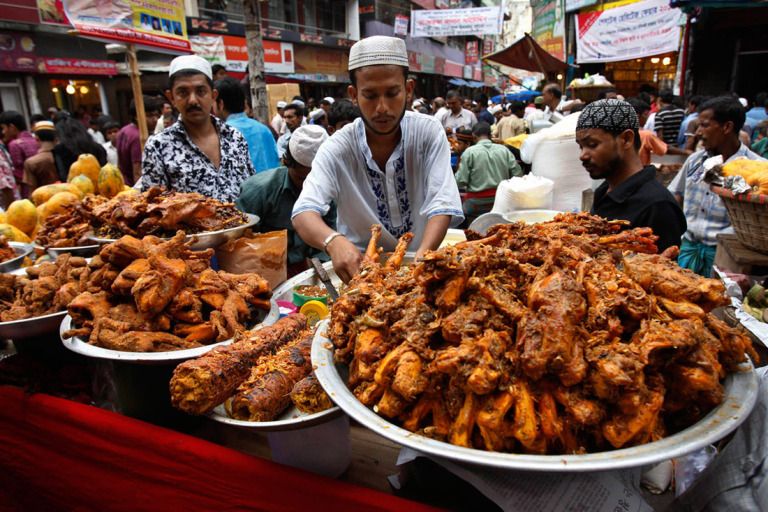Bangladeshi foods
The following is a list of characteristic Bangladeshi recipe styles. Each entry is a class of recipes, producing different dishes depending on the choice of ingredients. There are tastes to which the Bangladeshi palate cater to. These include:
Achar: Assortment of pickled fruit, vegetables or spices. Generally flavoured with mustard oil, mustard seeds, aniseeds, caraway seeds, and asafoetida or hing.[1]
Bawra (বড়া): Anything that has been mashed, mixed with thick batter and then formed into a rough roundish shape and deep fried, generally in soybean or mustard oil. Generally it is served with rice as a starter, or served with puffed rice crisps or as a single snack. The bora has quite a few kinds. When potatoes are fried in a light chickpea flour batter, they are called fuluri (giving rise to the Trinidadian pholourie).
Bhaja (ভাজা): Anything fried (especially potato, aubergine (eggplant), cauliflower, cabbage, fish, chicken) after it has been salted or dipped in any kind of water-based batter. Does not include croquettes or crumb-coated items.
Bhapa (ভাপা): Fish or vegetables steamed with spices.
Bhate (ভাতে): A vegetable that has been put in the pot where rice is cooking. It is cooked with the rice. Generally, the vegetable includes potatoes, butternut squash, raw papayas, bitter gourd, snake gourd and okra. It is often eaten with a tinge of mustard oil or ghee and salt. For this, generally "atap chawl" rice is used. It's is a short-grained, glutinous rice that cooks quickly and preferred because of its creamy quality and ability to become sticky. That aids the dish when it comes to mashing. At serving, fresh ghee or butter, and salt to taste, is mixed and mashed by hand and then eaten. A raw green chili, and a boiled and shelled egg, sometimes accompany this dish.
Bhorta (ভরতা): Any vegetable, such as potatoes, aubergine (eggplant), beans, sour mangoes, papaya, pumpkins and shrimp, dried fig or even dal, first boiled whole and then mashed and seasoned with red shallot, fresh chili, mustard oil/ghee and spices.
Chap (চাপ): Bengali-style croquettes, usually coated with crushed biscuits or breadcrumbs.
Chutney: Generally, the Bengal region is one of the pioneers for this dish, making it with everything, including preserved mango sheets, called amshotto.
Dom (দম): Vegetables, especially potatoes, or meat, cooked over a covered pot containing water, slowly over low heat, slightly steaming. The word is derived from the dum technique popular in Mughlai cuisine.
Ghonto (ঘন্ট): Complementary vegetables (e.g., cabbage, green peas, potatoes, banana blossom, coconut, chickpeas, etc.) are chopped or finely grated and cooked with pouron and ground spices. Dried pellets of dal are often added to the ghonto. Ghee is commonly added at the end. Non-vegetarian ghontos are made, with fish or fish heads added to the vegetables. The famous muri ghonto is made with fish heads cooked in a fine variety of rice. Some ghontos are very dry while others are thick and juicy.
Kalia (কালিয়া): A very rich preparation of fish or meat using a lot of oil or ghee with a spicy sauce usually based on ground ginger and fresh shallots pasted or fried along with a tempering of gorom moshla.
Kofta: Ground meat croquettes bound together by spices or eggs, served alone or in savoury gravy.
Korma: It involves egg, fish or meat cooked in a mild yogurt-based sauce with ghee, and often poppy seed paste is added. People of southern Bangladesh add coconut milk to many of their dishes and korma is no exception.
Paturi: Generally, oily fish is sliced evenly and wrapped in a banana leaf, after the fish has been basted with freshly pasted mustard with a hint of mustard oil, chili, turmeric and salt.
Posto: Anything (especially potato, aubergine) cooked with poppy seed paste as the main flavouring agent. Often poppy seed paste with some mustard oil is eaten mixed with rice all by itself as a mild beginner in a meal.
Shak (শাক): Green leafy vegetables, like spinach and mustard greens, are shredded and cooked until they wilt in a touch of oil and tempering of nigella seeds.
Torkari: A general term often used in Bengali, the same way 'curry' is used in English. The word first meant uncooked garden vegetables. From this, it was a natural extension to mean cooked vegetables or even fish and vegetables cooked together.

nice post